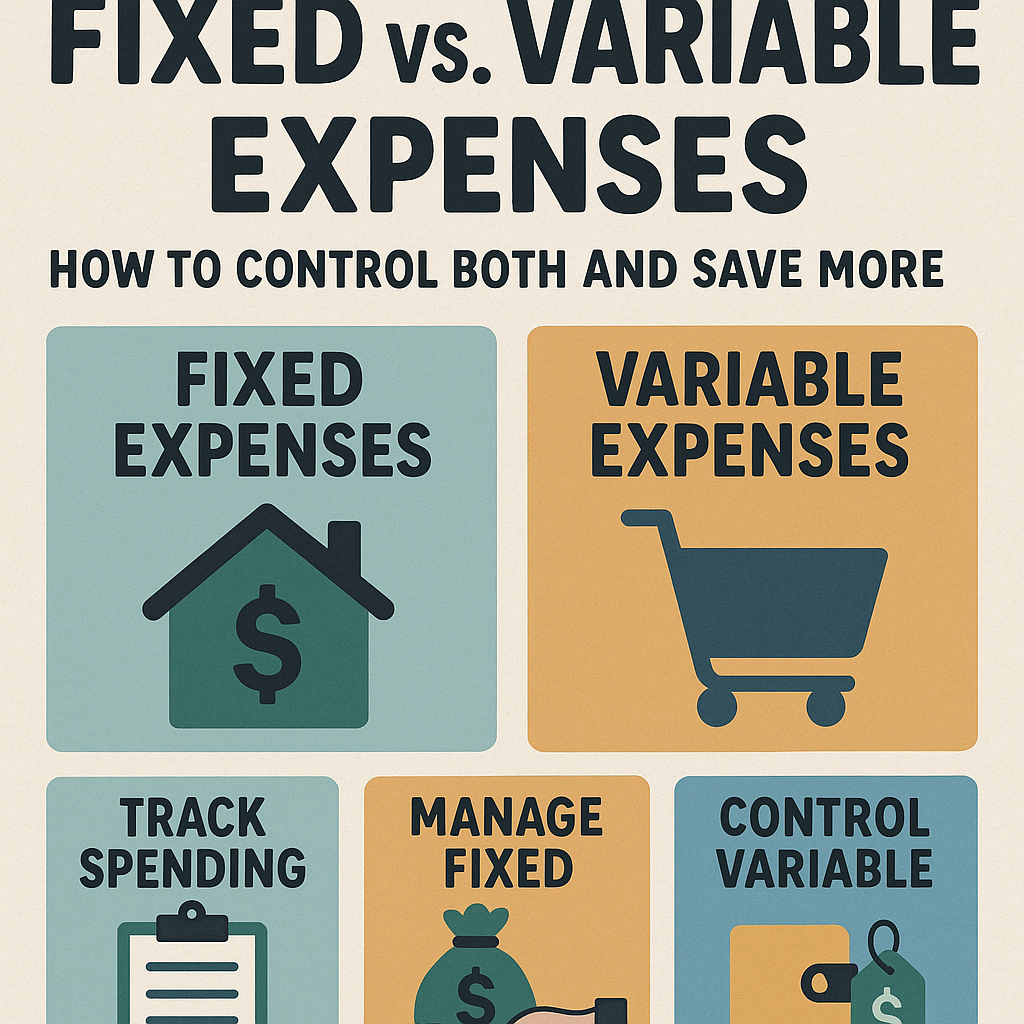If you want to take full control of your finances, understanding the difference between fixed and variable expenses is essential. These two types of spending behave differently and require unique strategies to manage. In this article, we’ll explain what they are, how they affect your budget, and how to control them to maximize savings.
What Are Fixed Expenses?
Definition
Fixed expenses are costs that remain the same each month. They are predictable and typically essential to your daily life.
Examples of Fixed Expenses
- Rent or mortgage payments
- Car loan payments
- Insurance premiums (health, auto, life)
- Subscription services (Netflix, gym, cloud storage)
- Student loan payments
Key Characteristics
- Same amount each billing cycle
- Usually tied to contracts or legal agreements
- Not easily reduced in the short term
What Are Variable Expenses?
Definition
Variable expenses change from month to month based on your usage, behavior, or circumstances.
Examples of Variable Expenses
- Groceries
- Dining out
- Gasoline or transportation costs
- Utilities (water, electricity, internet)
- Entertainment
- Shopping and gifts
Key Characteristics
- Fluctuate monthly
- Often more flexible and adjustable
- Easier to cut when budgeting
Why Understanding the Difference Matters
Knowing which expenses are fixed and which are variable helps you:
- Build a more accurate budget
- Identify areas for potential savings
- Make smarter financial decisions during tight months
You’ll also find it easier to adjust your lifestyle and spending patterns when you’re aware of which costs you can and can’t immediately control.
How to Track Fixed and Variable Expenses
Step 1: Record All Monthly Spending
Use a spreadsheet, budgeting app, or financial journal to list every expense over the past 30 days. Categorize each one as either fixed or variable.
Step 2: Calculate Monthly Totals
Add up the total amount you spend on:
- Fixed expenses
- Variable expenses
This will help you understand how much of your income is committed and how much is discretionary.
Step 3: Compare with Your Income
Subtract total expenses from your monthly income. If you’re overspending, you’ll need to reduce variable expenses—or consider adjusting certain fixed ones when possible.
Tips to Manage Fixed Expenses
1. Re-Evaluate Regular Bills
You might not think you can change your fixed expenses, but there are often opportunities to save.
- Refinance loans: Get a lower interest rate on car, mortgage, or student loans.
- Negotiate rent: In some cases, landlords are open to negotiation, especially if you’ve been a good tenant.
- Shop around for insurance: Compare quotes annually to ensure you’re getting the best deal.
2. Cancel Unnecessary Subscriptions
Are you using every subscription you’re paying for? Cancel services you rarely use and consider sharing accounts with family or friends (where allowed).
3. Downsize
If your fixed expenses are consistently too high, consider making bigger changes like:
- Moving to a smaller home
- Getting a more fuel-efficient car
- Paying off debts to eliminate monthly payments
Tips to Control Variable Expenses
1. Set Category Limits
Create spending limits for flexible categories like:
- Groceries ($400/month)
- Dining out ($100/month)
- Entertainment ($50/month)
Use cash envelopes or budgeting apps to help you stick to these limits.
2. Plan Meals and Shop with a List
Groceries are a major variable expense. Avoid overspending by:
- Planning weekly meals
- Using grocery store flyers and coupons
- Avoiding impulse purchases
3. Monitor Daily Spending
Review your transactions weekly to stay aware of spending habits. Small, frequent purchases often add up more than expected.
4. Use Rewards and Discounts
Use cash-back apps, loyalty cards, and discount codes whenever possible. Just be sure not to spend more than you planned just to earn rewards.
Building Flexibility Into Your Budget
Create a Buffer
Set aside a small amount each month (e.g., $50–$100) to handle unexpected expenses without dipping into savings or using credit.
Adjust Seasonally
Variable expenses often increase during certain seasons (e.g., holidays, back-to-school). Adjust your budget accordingly by saving in advance.
Why This Matters for Saving
By understanding and controlling both fixed and variable expenses, you can:
- Find opportunities to reduce monthly costs
- Increase how much you can save
- Respond better to financial emergencies
- Reach your financial goals faster
Small, consistent adjustments to your spending can lead to big results over time.
Final Words: Be the Boss of Your Budget
You can’t manage what you don’t understand. By learning the difference between fixed and variable expenses—and knowing how to manage both—you’re taking a powerful step toward financial freedom.
Start by tracking your expenses today. Then, tweak your budget based on what’s fixed, what’s flexible, and what can be optimized. Over time, you’ll build stronger financial habits that put you in control—not your bills.
